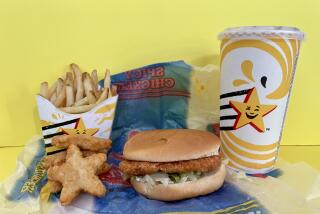The Bottom of the Food Chain
- Share via
If one thing is pushing PepsiCo to separate itself from its fast-food restaurant operations, it’s the realization that the industry’s poor performance in recent years is not going to improve soon, analysts say.
The saga of the firm’s Irvine-based Taco Bell unit shows why.
For years, the Mexican-style eatery chain has bolstered its financial performance by opening new outlets rather than by improving sales at existing stores. And its executives have been unable to generate the next trend-setting menu item needed to jump-start sales and profit.
Quite frankly, says Carlsbad, Calif.-based restaurant industry consultant Hal Seiling, Taco Bell has saturated the market and run out of steam.
Other fast-food chains, including PepsiCo’s KFC and Pizza Hut units, also are facing markets bursting with competitors. But Taco Bell has stumbled a bit more than the others, says Seiling.
Taco Bell President John Antioco disagrees. The divestiture, he says, will turn PepsiCo’s restaurant unit into a focused company with plenty of potential. Taco Bell will launch a new campaign--he wouldn’t elaborate--in television ads scheduled to run Sunday during the Super Bowl.
But Taco Bell hasn’t done much to grab consumers’ attention since it set the market afire in 1988 with a so-called value-pricing strategy that forced everyone in the industry to cut prices, Seiling says.
Value pricing was “the last good idea they had. . . . Everyone needs an encore, and they haven’t been able to come up with one,” he said.
The company’s most recent effort came almost two years ago when it unveiled its “Border Lights” menu of reduced-calorie items during the 1995 Super Bowl.
Several months ago, after spending more than $100 million on advertising, Taco Bell pulled the plug on the campaign and reduced its exhaustive “light” menu to just three items.
The campaign “was a dismal failure,” Seiling said.
It’s been a sad few years for the monster chain that grew from the little taco shop that industry pioneer Glen Bell opened in Downey in 1962.
That’s the principal reason PepsiCo wants out, says Robert L. Sandleman, a restaurant industry analyst based in Brea. “The restaurant industry is so different from the core businesses” of soft drinks and packaged snack foods of the Frito Lay division “that PepsiCo started looking at it as being a drag on its resources,” he said.
Taco Bell has an estimated 70% of the Mexican-style fast-food market in the United States, and “it is difficult in this kind of situation for them to keep growing” at the pace PepsiCo and its shareholders would like, Seiling said.
He believes that Taco Bell’s performance in recent years has dragged down PepsiCo’s entire fast-food operation. Sales at stores open at least a year were down 4% in the company’s fiscal 1995 and are off by about that much through the first nine months of fiscal 1996. PepsiCo does not report earnings for individual chains, but it said that total restaurant division profit was down 9% on flat sales in its fiscal third quarter ended Sept. 7.
For most of its first two decades, Taco Bell pretty much had the market to itself. Mexican food was virtually unknown outside of Southern California and fast food was defined by the hamburger stand.
By the early 1980s, though, Taco Bell’s growth had caught the eye of other restaurant entrepreneurs and the taco wars began. Upstarts Del Taco and Naugles--both headquartered in Orange County--were battling Taco Bell at home, and other regional chains began adding tacos and burritos to their menus. Del Taco and Naugles have since merged.
Taco Bell was slow to react, though. It often followed its competitors into the market with new items. Naugles and Del Taco were offering nachos months before the dish made its way onto Taco Bell menu boards. Taco Bell was also one of the last chains to begin offering breakfast items.
By the mid ‘80s, analysts said, taco shops had become mainstream fast food. But their success, personified by the Mission-style Taco Bell buildings cropping up in almost every town, meant they had to compete not only with one another, but with the hamburger, pizza and fried-chicken chains as well.
More to Read
Inside the business of entertainment
The Wide Shot brings you news, analysis and insights on everything from streaming wars to production — and what it all means for the future.
You may occasionally receive promotional content from the Los Angeles Times.










